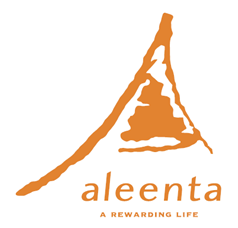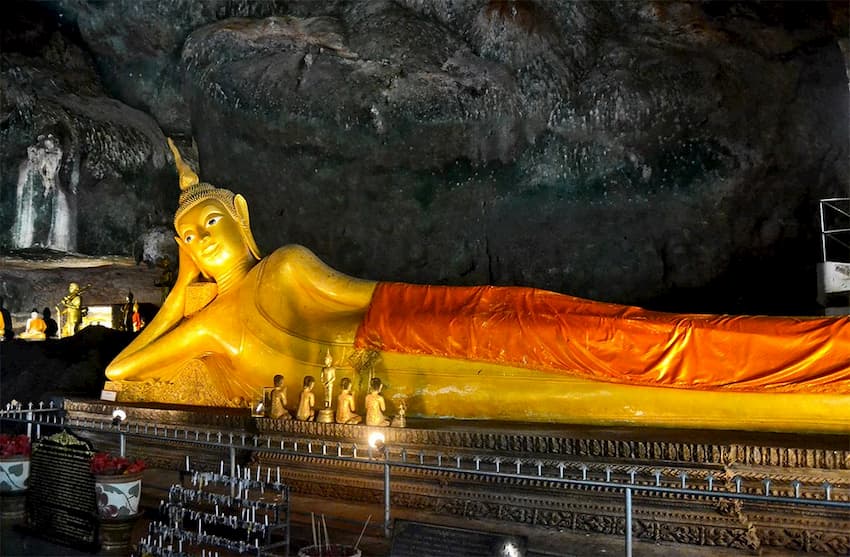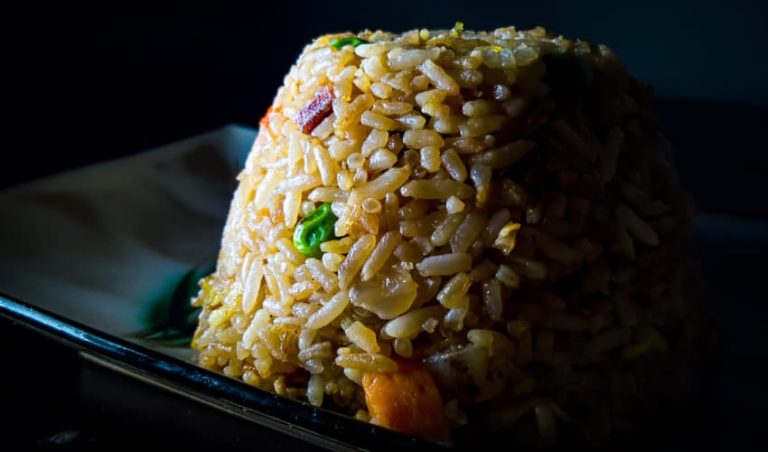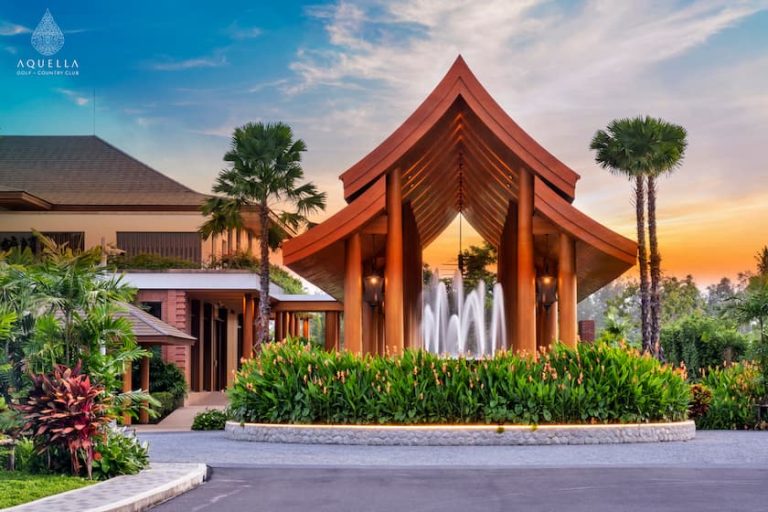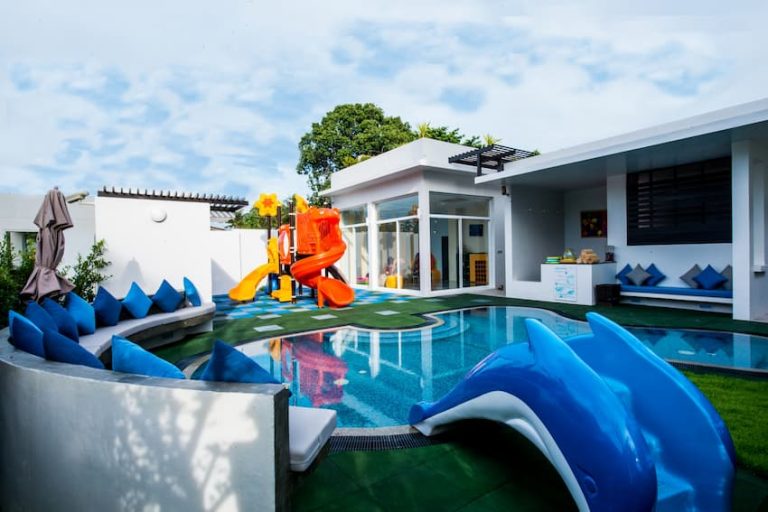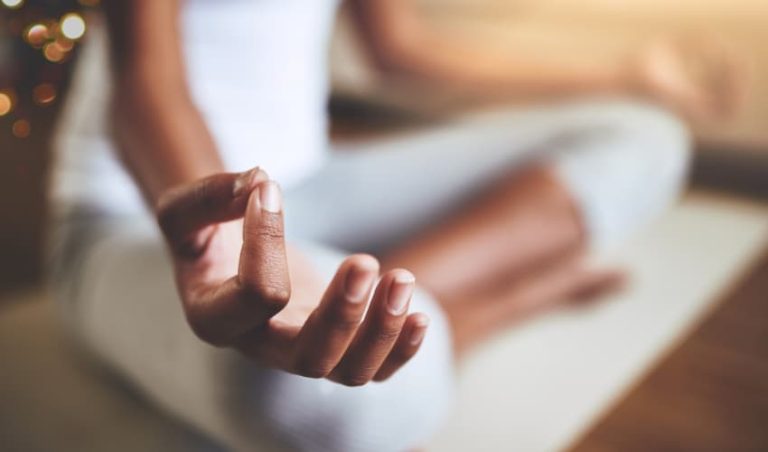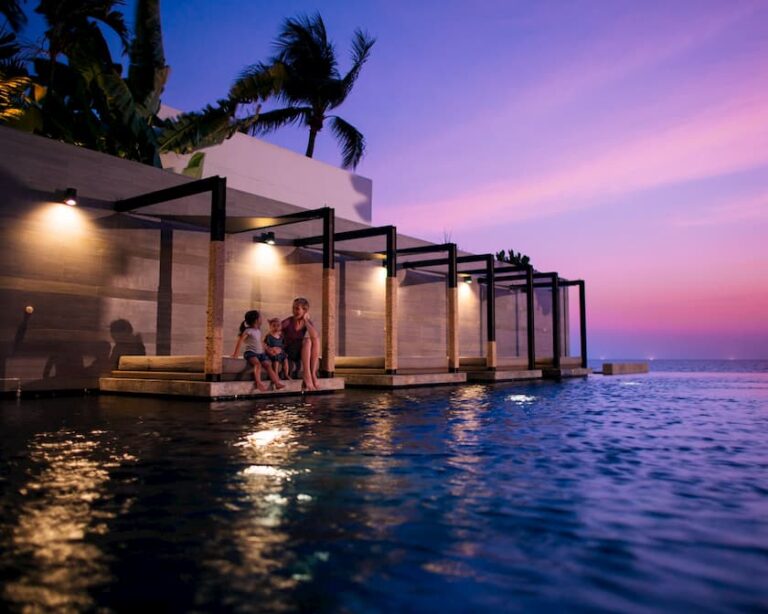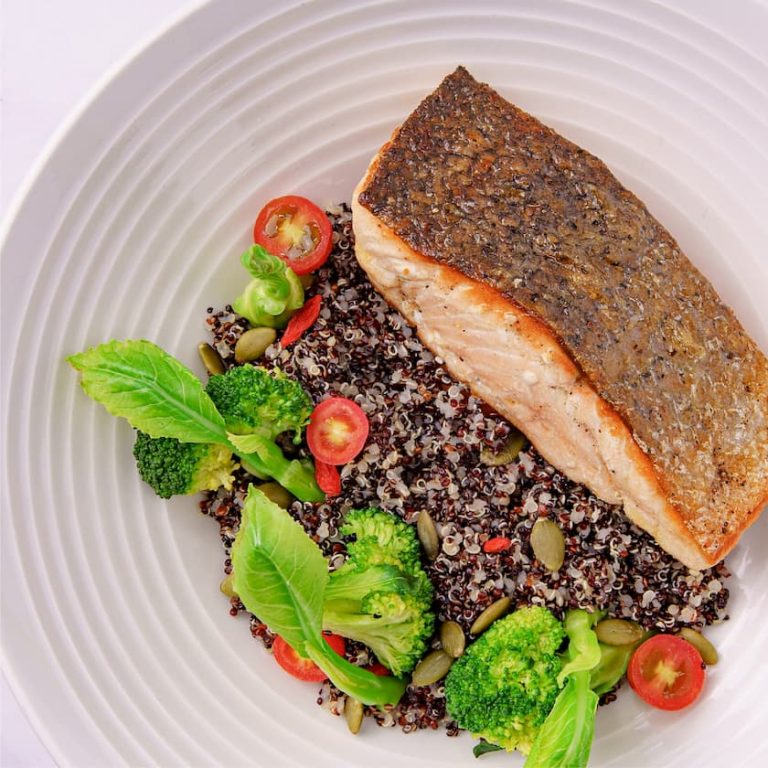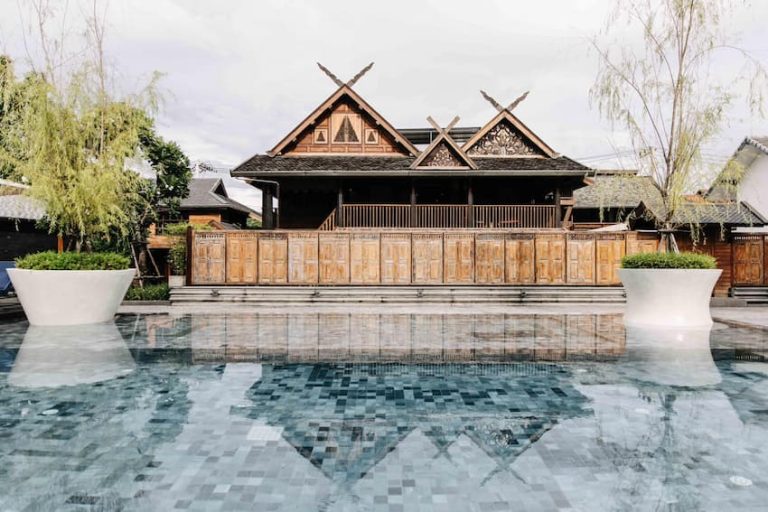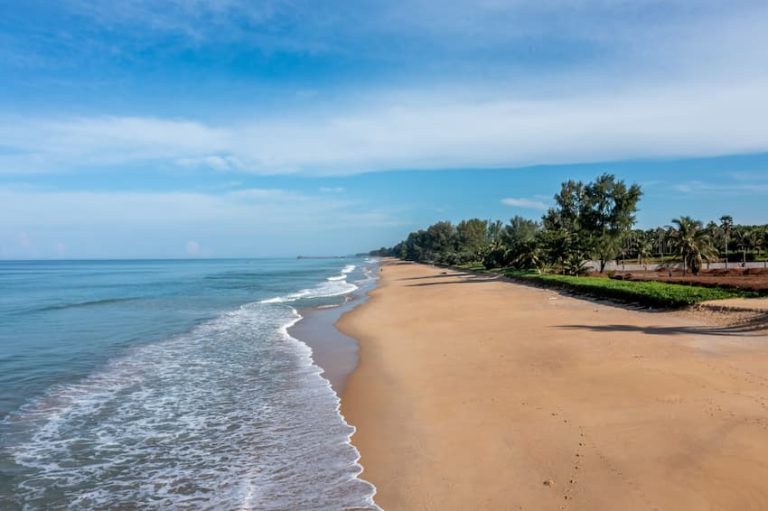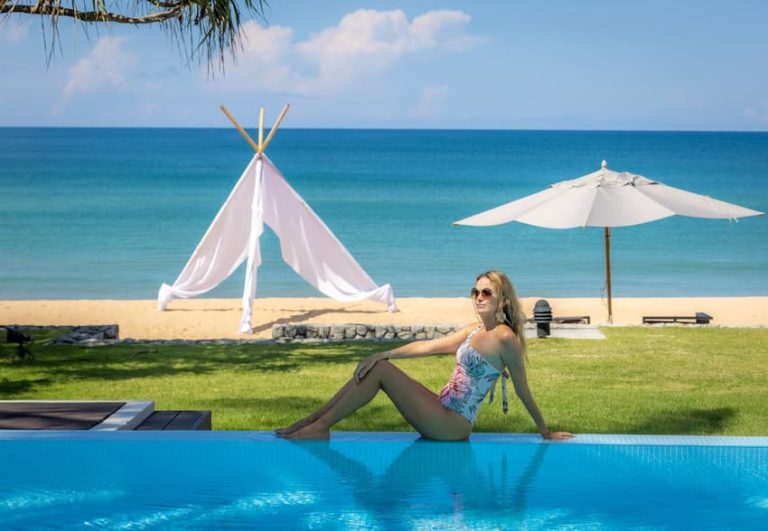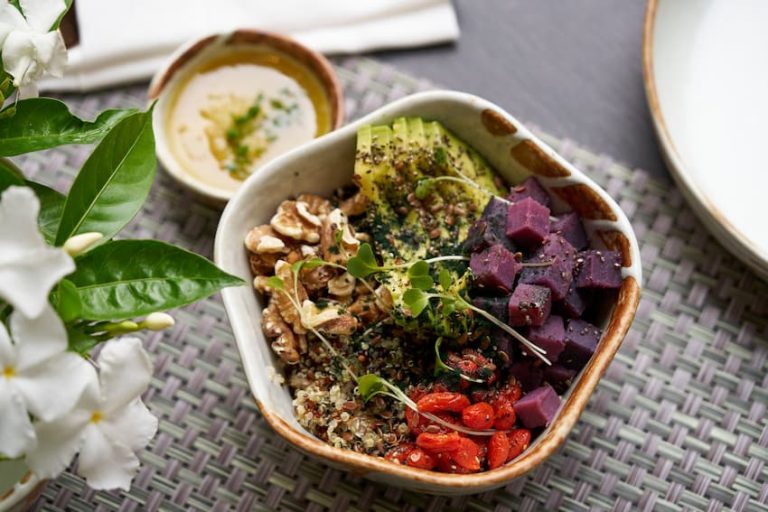In the southern province of Thailand, on the Andaman Sea coast, you will discover Phang Nga. This is where some of the most popular temples throughout the Phang Nga province are located. These temples are beautiful for numerous reasons including the fact there were no alterations made to the caves to accommodate the temples. The scenery is peaceful and tranquil with stalactites and stalagmites of limestone. It is not easy to reach the cave temples due to the long walks up the staircases and the limestone entrances. Your destination is worth every single step.
Phang Nga Temples
1. Wat Suwan Khuha
Wat Suwan Khuha is a temple affectionately referred to as the temple cave or Wat Tham by the locals. The temple was constructed directly into the limestone mountain or karst of Takua Thung. There are numerous caves to explore inside. The lowest and largest cave is referred to as the Big Cave and Tham Yai. This is where the entrance to the temple is located. The cave measures twenty metres in width and forty meters in length. One of the most popular attractions of this temple can be found here. This is a fifteen metre golden reclining Buddha. If you look around, you will see numerous sitting and standing Buddhas although they are a lot smaller. The cave entrance features a colourful gate with the depiction of several different figures including another Buddha.
Do not park too close to the temple despite the available parking. There are a lot of monkeys close to the temple who may cause damage to your vehicle. Several cats also make their home here. You may even see the monks meditating right in front of the Buddha. Wat Suwan Khuha is one of the most important temples in the entire Phang Nga providence because of the archaeological and historical background. The other caves include the Tham Chaeng, Tham Kaeo, Tham Muet and Tham Yai. This is located on the lowest level. The length of the caves have been beautifully decorated with crockery and ceramic tiles. The cave is used as a chapel or a wihan. You will see the images of several Buddha’s that have been enshrined. The reclining Buddha is the most important of them all.
One of the other caves has the initials of the royalty including both the kings and the royal family. This includes King Rama V the Great, King Rama IX the Great, Queen Rambhaibarni and King Rama VII. Directly in front of this cave is where all of the monkeys come to feed. You will find this temple approximately twelve miles to the south of Phang Nga right off Route 4.
2. Wat Tham Ta Pan
** Do to the graphic nature of the heaven & hell statues, this may not be suitable for children **
You will find Wat Tham Ta Pan in Wat Tham Ta Pan town. This temple is often referred to as the temple of heaven and hell. This is due to the exhibit featuring a depiction of the Buddhist concept of heaven and hell. When you first look around, you will notice the temple appears to be slightly neglected. You will see the traditional deities and animals. Despite the lovely scenes representing heaven, what you are going to remember is Sin Park. This is one of the smallest hell temples in Thailand. Most people find this this temple both disturbing and impressive. The beginning of this temple is the mouth of an enormous dragon. Your steps will lead you through the belly of the dragon. The tunnel is damp and dark with the only light coming from the few windows in flickers.
You will then walk through the cave representing heaven, coming out at the entrance of hell. This is where you will view the tortured and maimed statues. A lot of these statues are accented with red paint to ensure you can see their fresh wounds. Some statues are forced to make the climb up trees lined with spikes, others are being strangled or lanced with a spear. This scene is meant to be gruesome to show sinners what will happen if they do not adhere to Buddhism’s Five Moral Precepts. The design was intended to terrify sinners into walking the correct path with faith and good behaviour. There is a fountain at the entrance including statues of five monks. Each monk holds a bowl representing a different desire. These are wealth, happiness, beauty, health and cleverness.
The tradition decrees if you can toss a coin successfully into any of these bowls, you will receive the desire linked to that bowl. There are several different buildings on the temple grounds such as a snack shop. Walk behind these buildings and you will find a beautiful garden full of animal statues. Continue past the garden until you see the cliff. There sculptures here represent Hindu deities including Akhilandeshvari and Ganesha. When you stop at the snack shop, there is a dragon next to the shop with an open mouth. This is the entrance to a tunnel that will take you ti a cave with statues of Buddha representing heaven. When you exit the cave, you will be in an outdoor area. There are numerous statues depicting the torture in hell waiting for the sinners. If you have children, you should not take them to this exhibit.
You can choose to explore Wat Ta Pan on your own or hire one of the native guides.
3. Wat Rat Uppatham
Wat Rat Uppatham is also called Wat Bang Riang. This temple is located in the district of Thap Put on Khao Lan Mountain. This is where you will find the Chedi Phutthathambanlue. This is a pagoda or chedi shaped like a bell. The pagoda overlooks the scenic mountains and hills, an extremely large statue of Buddha sitting directly under the seven-headed serpent Naga and Guan-yin, the Chinese Goddess. This is the biggest temple anywhere in the province of Phang Nga. At a height of 109 meters, no other temple in Phang Nga has achieved this height. Some of the Buddha’s sacred relics are found in this temple. At the base of the temple, there are niches containing carved golden Buddhas. This includes Guan-yin, the individual capable of reaching ideal enlightenment or Bodhisattva.
Guan-yin is linked to both compassion and mercy. This is the reason she is referred to as the Goddess of Mercy and believed to bring good luck. The statue of Guan-yin overlooks a lovely courtyard featuring a shimmering pool. The decorations inside of the temple are lavish including numerous Buddha statues, paintings and carvings featuring monkeys. Ornamentation in yellow-orange, blue and red cover the walls. The formal name of this temple is Wat Rat Uppatham. This translates to a temple with the support of the locals. Abbot Lung Por Chai originally established the temple after he came to the area approximately thirty years ago. There were no temples, so a few of the locals had asked for help with a funeral. As time went by, Lung Por Chai added additional statues and structures to the temple so it would be more attractive and interesting for travellers.
4. Wat Lak Kaen
You will find the Wat Lak Kaen temple is located just south of Khao Lak in the Takua Pa district. This temple is also one of the monasteries in Thailand. Approximately twenty monks live here to serve the community of Ban Lak Kaen. This building is called an Ubosot. In a Wat complex, this is considered the most sacred of all buildings. Buddhism is represented by the triple gems. These are the Buddha, the Buddhist philosophy or the dhamma and the Buddhist community or the sangha. The triple gems are represented in the three different levels of the roof. The shape of the roof tiles are similar to the mythical serpent believed to have protected Buddha during meditation. The tiles are red to further signify the serpent. You can see a large statue of Buddha housed in the Ubosot for both prayer and ordinations.
If you are familiar with the mystery of the nine stones, the answer has finally been revealed. Buried around the Ubosot are nine protective stones. This is what sanctifies the temple. Stones like this have been seen at other temples during renovation. In some instances, the stones are shaped like large, round balls. Cardinal point are chosen for the burial of the first four stones, another four are buried between these points with the ninth buried right under the Ubosot. If there are any other stones, they are buried with monuments serving as markers. Several areas of this temple were destroyed in 2004 by the tsunami. This includes the Ubosot. The previous Ubosot was destroyed during the tsunami of 2007 and had to be rebuilt. Not only is this the holiest building located in the complex, this is where the new monks or priests are ordained.
The construction of the new Ubosot was concluded in 2007. You will see an altar inside of the Ubosot featuring a golden seated Buddha. There is also a monastery inside of the complex where twenty monks live. All of the buildings are white with red roofs and golden trim.
5. Dragon Cave Temple
Both the Dragon Cave Temple and Wat Suwan Khuha are located inside of a cave. The Dragon Cave is located in Thap Put in a mountainous and remote area. According to the local legend, there are healing powers in this cave. This is why so many individuals with serious illnesses such as cancer would visit the cave so often. The monks who live in the area make special herbal teas believed to lower the cholesterol levels and blood pressure of the people. The monks demonstrate meditation in the Buddhist way. This includes showing the people the correct way to chant mantras. You will notice all of the winding stairs and smaller shrines throughout the temple. These are decorated with numerous holy figures including Buddha. In addition to the shrines, there are carvings, statues and paintings. There are a few tour companies offering a package deal including the Dragon Cave Temple, Wat Rat Uppatham and Wat Suwan Khuha.
The Praya Nakarech Temple was built in a limestone cave on a limestone mountain approximately 50m in height. This temple has become extremely famous for their special home brewed tea. Tests have been performed on this tea in a laboratory. The results showed you can lower your cholesterol level by drinking this tea. One of the only monks who permanently lives here is the head monk. He has received official certification as an herbal doctor. Individuals who have suffered difficult experiences during their lives can find shelter at the Praya Nakarech Temple. These individuals have experienced a psychological toll and need time to be able to live a normal life again. Although this does have some similarities with a sanatorium, it is different.
6. Wat Manee Sri Mahathat
You can find the Wat Manee Sri Mahathat temple by visiting the Takua Thung district. This new temple was constructed after the tsunami. Approximately eight years were required to complete this temple. Some of the locals refer to the Wat Manee Sri Mahathat temple as the temple of the black monk. This is due to the enormous black statue honouring Por Than Klai. This is a monk who passed away in 1970. He was one of the king’s favourites and the belief is he was gifted with prophetic abilities. You can see one of the buildings located in the complex containing almost life sized wax figures of some of the most famous monks. Some of them lived several centuries ago in the past. The wax figures are protected from the heat with air conditioning.
The Ao Phang Nga National Park offers you numerous different attractions in addition to Wat Manee Sri Mahathat temple. This includes an interesting little museum with several different rooms. You can see numerous famous monks in life size wax figures. There are also Indian and Chinese statues. Look for the museum towards the right side of the temple complex. Everything is extremely well maintained and in excellent condition. There is a lot to see here and you will enjoy the peaceful and serene atmosphere as well as the air conditioning.
Related Articles:
- Temples in Phang Nga, Thailand
- National Parks In Phang Nga Province
- Wat Suwan Kuha Temple in Phang Nga
- Ao Phang Nga National Park
- Khao Lak-Lam Ru National Park
ALEENTA PHUKET RESORT & SPA
33 Moo 5, Khok Kloi,
Takua Thung, Phang Nga
82140 Thailand
